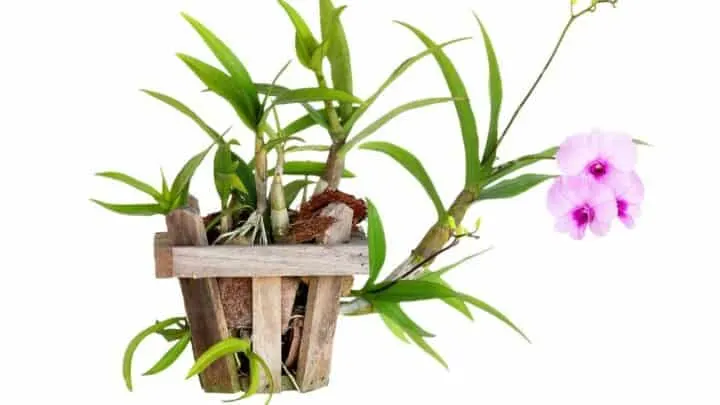Some orchids are essentially air plants brought to earth, and their roots need good air circulation and water circulation to survive.
Even the American varieties that grow in soil need a vessel that drains well and does not crowd their roots. Thus, containers with holes will stimulate the growth and health of orchids.
Consider air plants in nature, and you will understand. For example, orchids attach themselves to the bark of trees.
Here they are nurtured without soil. Their growth medium is the tree to which they are attached.
Orchids native to the United States are ground-dwelling variants of this plant.
There are varieties of these lovely flowers from the wetlands, which prefer consistently damp soil.
In comparison, upland varieties of orchids prefer a drying-off period between rains, just as they would receive in nature.
Since they grow best in moss, loose soil, and just water in some instances, orchids need to be footloose to thrive. Read on to learn why do orchid pots have holes.
Table of Contents
Why Do Orchid Pots Have Holes?
Orchid pots have holes to facilitate the flow of oxygen and water. If the roots of your orchid do not get a free flow of these two essential ingredients, they will not be healthy and may fail to bloom. If you think you are using the wrong pot to grow your orchid, find a container with holes, and you should get better results with your plants.
Air Or Land Orchid: What Do You Have
Whether you are growing a terrestrial orchid or an epiphytic orchid, they both need room for air and water to circulate their roots.
Terrestrial orchids include the delicate Lady’s Slipper, Blue Tila, the Yellow Ground orchid, and so many, many more.
These lovely plants will grow outside in temperate zones and do very well indoors in planters for those who live in cooler climates.
Epiphytic orchids are air plants and include more species than I have time to list. Some common varieties are Lemon Drop, Vanda hybrids, and the Cattleya.
As with all plants, some are easier to grow than others. Start with a more common orchid before venturing off into the realm of the exotics.
The practice will give you the experience you need to keep your plant alive when you find a rare plant you want to acquire.
Do All Orchid Varieties Need Pots With Holes: The Answer
No, however, your orchid may not grow as well or bloom as well. This is because the holes in an orchid pot facilitate unrestricted airflow around the roots of your orchid, which is required for a healthy plant.
However, a shallow pot with ample drain holes will work fine for some varieties of orchids.
If you do not have a shallow vessel or one with holes, you can use a deep pot and add lava rock or stone instead of filling the pot with moss or orchid bark.
This is because the roots of an orchid behave in a different manner than other plants. Orchid roots spread out, as opposed to going down.
Consider also the material of the pot. Classic clay pots drain well, and you can find orchid pots made of this material.
In addition, they are heavy, so they stay in place and hold moisture well.
Clear plastic orchid pots have become popular. You can see the roots with clear plastic pots, and the roots get more sun to convert into energy for growth.
The Best Plant Medium To Use In Orchid Pots
Orchid bark comes from the fir tree and is what is commonly used as an orchid growth medium. It is not an absolute, though, and you can also use perlite, sphagnum moss, coconut husk, tree fern, diatomite, or even charcoal.
Many of you who grow orchids make your mix using a little of each of the above ingredients.
However, like other plants, every orchid has different nutritional requirements, and a little more of one item and a little less of another may work out perfectly for your plants.
There are epiphytic orchid varieties that grow pretty well wired to a piece of cork or tree fern.
So the bottom line is, there is no best plant medium for orchids overall, but there is the best medium for your particular orchid.
Does Pot Color Matter
It sure can. If the window that your orchid lives in has a total southern exposure, the color of your pot is a big deal.
A dark-colored pot could overheat the roots of your orchid. Not good, and even the brick red color of a terra cotta planter may be too dark for your plant.
White pots, clear pots, or pots of lighter colors work best. However, some coatings of glazed pots can leach into your plant’s growth medium, so take care to get pots that are made for orchids.
Frequently Asked Questions About Why Orchid Pots Have Holes
How can I tell if my orchid needs repotting?
Since the roots of orchids are visible and a tangled mass of organic matter, it is hard to tell by just the roots if it needs to be repotted. The best practice for repotting your orchid is every year or two. Any longer, and your plant’s health could suffer.
Do I need to use a particularly sized pot for my orchids?
Orchids are not large plants and can be grown in a pot between four and six inches in diameter (10.2-15.3cm). However, some larger or older plants may need a larger pot, and remember, orchids roots run outward, not downward, so a shallow vessel for your plant is acceptable.

Daniel has been a plant enthusiast for over 20 years. He owns hundreds of houseplants and prepares for the chili growing seasons yearly with great anticipation. His favorite plants are plant species in the Araceae family, such as Monstera, Philodendron, and Anthurium. He also loves gardening and is growing hot peppers, tomatoes, and many more vegetables.


